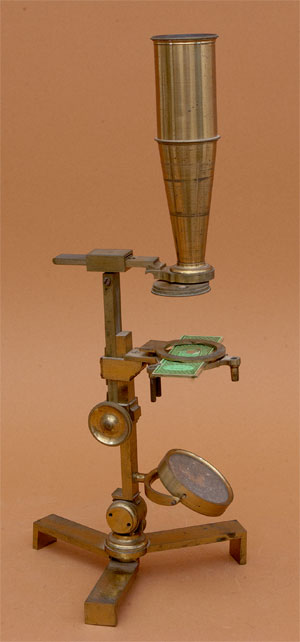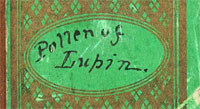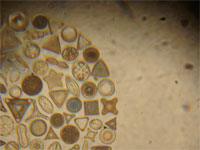 |
|||||
 |
 |
||||
 |
|||||
 |
 |
||||
Gilbert & Sons Compound Microscope (No. 147 ) |
|||||||
 |
Age: c1818 Made by: possibly Gilbert & Sons Made in: England |
||||||
 |
|||||||
|
Accessories
|
|||||||
 |
|||||||
|
Imaging
|
|||||||
|
This instrument is a universal microscope similar in body style to the Gould design except for a number of additional features. The body is supported by a three-leg stand with a compass joint at the base. The focus mechanism is similar to that of the Cuff microscope with a fixed support pillar (rectangular in cross section) and a sliding focus pillar. However, a knob actuates a rack & pinion (as opposed to a Hevelius screw) to move the back, sliding pillar and therefore microscope body up or down. The microscope body is supported at the end of a brass limb fitted into a rectangular frame mounted to the top of the sliding pillar. The limb can be translated to position the objective along the optical axis. The stage consists of a fixed base and a moveable upper ring. Sample slides are positioned between the stage rings. The microscope can be operated either as a compound microscope or a simple magnifier, thus the universal designation. For the latter operation a single biconvex lens can be screwed into the limb. To act as a compound microscope a rotating objective turret would be screwed into the bottom of the limb and a compound body into the top of the limb. In this case the optics are typical 18th Century with an objective, field lens and eyepiece. The eyepiece is unusual however as it consists of two biconvex lenses with an aperture in between. The objectives are unusual in that they are in a rotating turret that holds six biconvex lenses of various focal lengths. With the legs folded the entire instrument can be stored into a mahogany case. Imaging is fair to good depending on the magnification, although they do exhibit some chromatic aberration and relatively low resolution. Accessories consist of a Lieberkuhn, stage and sample forceps, two glass stage inserts, a fish plate, Black/White disc, and three sample slides made by "J. Escreet". This microscope in the Golub Collection appears to be identical to an instrument in the Billings Collection (p25, fig 48), which is signed "Gilbert & Sons, London". The Gilbert family was a prominent instrument making family through the latter half of the 18th and beginning of the 19th Century. William Gilbert apprenticed to his father, John Gilbert July 4, 1769; subsequently was turned over to Peter Dollond July 18, 1769; free of the Grocers' Company Aug. 1, 1776; admitted to the Spectaclemakers' Company Dec. 1, 1801 by Redemption (purchase); finally Master of the Spectaclemakers' Company 1807-09. William produced instruments throughout several eras starting as Gilbert & Wright (1790-92), followed by Gilbert, Wright & Hooke (1794-1801), Gilbert & Wright (1802-05), Gilbert & Sons (1806-18), Throughout his partnerships Gilbert's shop was at 148 Leadenhall Street, Navigation Warehouse, London. William's sons were William Dormer Gilbert and Thomas Gilbert. |
|||||||